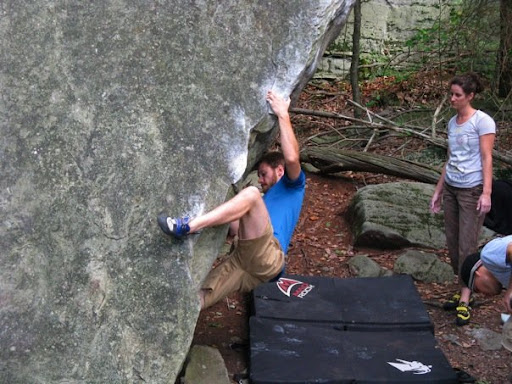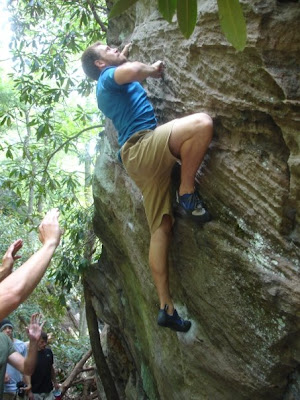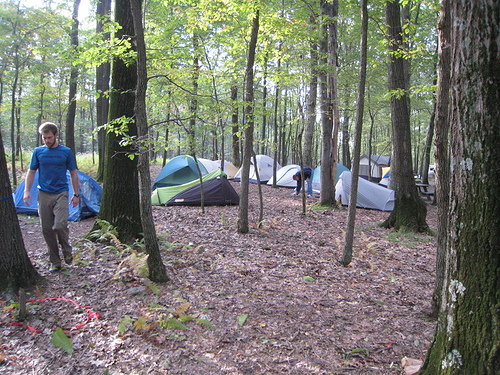
Bouldering at Coopers Rock, WV - photo by Rian Landers

Bouldering at Coopers Rock, WV - photo by Laura Bussolini
Driving several hundred miles and several hours has become unfazingly common. For entertainment I search the lower bands of FM radio for NPR stations. If not available then I usually wrap my headphones around my ears and play a podcast--Wait, Wait, Don’t Tell Me, This American Life, al-Minbar al-Hurr (a German Radio Program in Arabic)--which forces my mind to wander through the realm of thought and away from the monotonous mile after mile of freeway.
This trip it was a This American Life episode on “Fear of Sleep”. Several interviewees recounted experiences that either, through trauma, contributed to sleeplessness or, through science, explained it. Lately it seems that the shows producers are experimenting with the format, including a comedy skit as one of the acts. This episode it was Mike Birbiglia, a (formerly) sleepless comedian who retells his comedic nighttime experiences through his sketch, “Sleepwalk With Me”. Several other narratives involved roaches, bed bugs, faulty dopamine producers, and anxiety. Fortunately, I’ve never been a victim of severe sleeplessness, thus can’t relate. About the closest experience I've had is reportedly trying to smash my fingers repeatedly in a closet door while sleep walking. Nevertheless, the show is a window into the lives of compatriots, lending greater insight into what it is to be both an American and, more generally, a human being.
As the show played on I couldn’t help but peek into adjacent vehicles and wonder about the lives of my freeway companions. Most plates were local, but the occasional through traveler was sighted. I started to wonder about their lives, where they were going, what they were doing, if they were happy, how they passed their time on this giant concrete funnel. From most vehicles little can be discerned about the occupants’ lives. But there is the occasional military or political bumper sticker off which lifestyle sketches may be drawn.
What I was most concerned about at this particular point was the relationship between concern and anxiety. In my case I do not lack concern or live a carefree life, but I never bother being anxious because anxiety is not action but a constant state of worry about some future action or occurrence. It’s very possible that anxiousness could cause a person to overlook the correct action that would alleviate his or her source of worry. It seems to me that in our society there is an emphasis on anxiousness as a companion to concern, rather than a mishandling of concern. It made me question which side is more crazy, the anxious worrier or the insouciant drifter.
When I finished with my mental version of This American Life, I turned to al-Minbar al-Hurr. This episode involved a discussion between Middle East “experts” in Europe about which direction Mauritania should proceed in the wake of its latest failed democratic experiment, which ended in a military coup. One side believed that the former president, Sidi Ould Cheikh Abdallahi, should be reinstated until economic and security stability is reached, at which point the country would be ready for the democratic process. Another argued that no past systems could be relied upon because Mauritania’s past is saturated with institutional stigmas such as nepotism, favoritism, and classism. He favored a form of military rule until a new election could be held. After a while I drifted into a sea of thoughts, mulling over all the world’s nascent democratic experiments and what they all share in common. It seems to me that many of the countries attempting democratic reforms are simply not ready; it’s being forced upon them. Forcing an old world country to democratize is much like taking an American first grader with ADD and forcing him to meditate. Meditation is a gateway to Enlightenment just as the democratic process is a pathway to individual freedom. Yet, even if the first grader has been told that meditation is good, he does not understand why he should meditate, nor does he possess the capacity. In the same way, one cannot be forced to participate in a democratic process if he or she does not understand individual freedom. Most old world cultures lack individual identity, much less freedom, relying instead on social class and/or tribal, national, or religious identity. Where these mentalities are present democracy is prone to failure.
After a few days in this hotel I’ll be headed to yet another temporary residence. And what move wouldn’t be complete without a several hour long drive? I’m comforted knowing that wherever I go there will always be something to climb, great vegan food to be sought out, and more entertaining episodes of my roadway companion programs. If not, I’ll be moving on soon as you can say, “Democratize Now”. Now it’s lights out in this hovel. This traveling homeless is hittin’ the sack.

Tent City at Coopers Rock, WV - photo by Rian Landers













